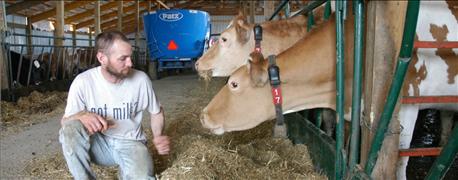March 13, 2016

As a kid, I had a tendency to move faster (a lot faster) than I do now. Whether we were in the field or cleaning the barn, the faster my brothers and I worked, the faster we could move onto something more interesting, such as hunting gophers or adventures yet to be discovered.
The concept here was the faster we worked, the more we would get done, at least until it came to handling cows.

Learning how to "read" cattle will improve how their stockmanship skill.
Growing up on a dairy, beef and small-grains farm, we never had a lack of things to do and usually did not have enough time to do everything we wanted to do. We worked long and hard hours to sow crops or bale hay, but when we rushed the cows, the experience was usually counter-productive. The cows had their pace, and it wasn’t in line with ours. And, unfortunately, when we tried to change that pace, the result was more destructive than productive.
As people learn to apply stockmanship handling skills on cattle operations through experience (provided we are paying attention) or through the teachings of our elders, I realize many of today’s livestock employees do not have a farm experience, let alone an animal experience.
Whether that be dairy, sheep, hogs or horses, each species has its own tendencies, but not necessarily actions in common, and these tendencies do not come naturally to new livestock handlers. Even when you and the animals do get accustomed to each other, a frequent question arises about what to do with new cattle.
As simple as it may sound, the answer is that the behavior of the animals will tell handlers what should be done with them.
For example, if cattle run back and forth or circle nonstop, the handlers need to slow their motion. If the cows bunch in a corner and have no movement, a handler, or at most a few handlers, should create slow movement that involves teaching new cattle to accept human pressure. This also helps animals learn the boundaries of their new confinement while teaching them where they can find food and water.
Each time cattle are worked properly, they learn and become easier to work the next time. If you don’t believe that, compare a newborn dairy calf that typically has an assisted birth and is fed colostrum two to three times within 24 hours with a beef calf that typically is delivered on pasture unassisted and not handled by humans if not necessary. Which one wants to suck your hand and which is content to leave you behind?
The message here is that animals learn calm handling if handled calmly.
Authors Paul Rapnicki, Margaret Perala and Don Hoglund, in their article “Dairy Stockmanship - Reconnecting the People with the Cows,” explain that when livestock operations only consider working cattle if specific tasks are to be accomplished (such as vaccinating), a negative impression of handling can be imprinted in the cows’ memory.
Naturally, negative interactions can make animals become harder to handle through time. Frequently, we find that older cows in a herd can be difficult to move. We must understand that their current behavior is the sum total of the interactions, positive and negative, with humans throughout their lifetime.
Dairy stockmanship is about reconnecting people with dairy cows for positive outcomes, and it is fundamentally about learning how cows respond to the behaviors of people in a dynamic environment.
Animal husbandry has many components that are science and art, including animal behavior. As stock people, we have the responsibility to understand our animal subjects while we help our employees understand (get comfortable with) them.
Both are learned behaviors not found in books. I learned mine through boots-on-the-ground experience, but then I was one of the lucky ones. I grew up on a farm - a dairy farm where those cows were doing more than feeding a hungry world; they were teaching me about life, stewardship and a desire to become an animal scientist. I hope their lessons have made me a better teacher (and student) of dairying.
JW Schroeder, is a North Dakota State University associate professor emeritus and retired Extension Dairy specialist.
You May Also Like




